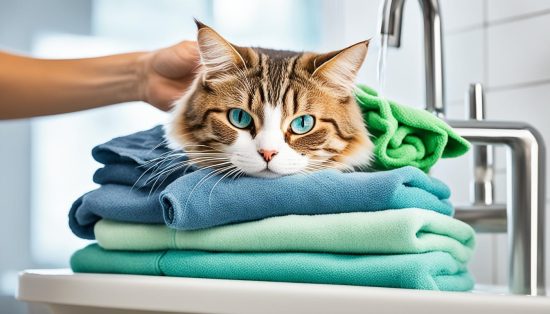Why Do Cats Wag Their Tails? Understanding Cat Tail Language
Uncover the meaning behind feline tail wags with our guide on why cats wag their tails and decode your pet’s mood and intentions.
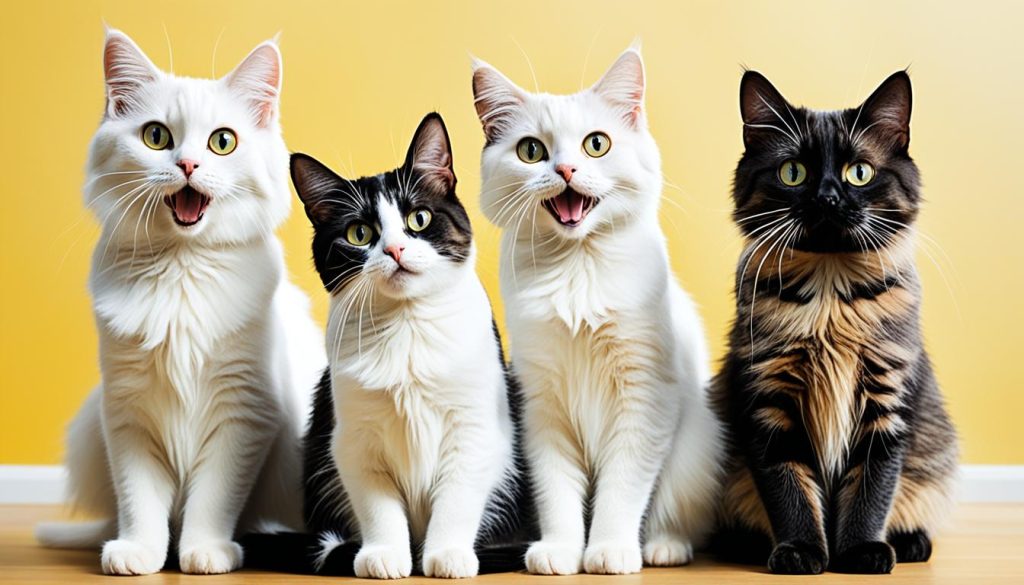
Did you know that cats use tail movements, along with other body language cues, to communicate their mood and intentions? Understanding cat tail language is crucial for cat owners to effectively interpret their pet’s emotions and needs. By observing and analyzing different tail positions and movements, you can gain valuable insights into your cat’s behavior and enhance your bond with them. We will delve into why cats wag their tails and how to interpret their tail language. By the end, you’ll be equipped with the knowledge to decipher your cat’s tail positions and understand their true meaning.
The Significance of Deciphering Cat Tail Positions
Cat tail positions play a significant role in feline communication. Cats use their tails as an extension of their emotions, expressing various messages through different positions. Deciphering these positions allows us to understand their mood, intentions, and level of comfort. By paying attention to the position of their tail, you can respond appropriately and create a harmonious environment for your feline companions.
Interpreting cat tail language is essential for cat owners to establish a deeper understanding of their pet’s needs and emotions. Cat tail positions serve as a non-verbal form of communication, conveying a range of messages that can help us better understand our furry friends. When observing your cat’s tail, consider the following:
- The height of the tail
- The angle at which it is held
- The level of movement or stillness
These factors can provide valuable insights into your cat’s current state of mind and overall well-being.
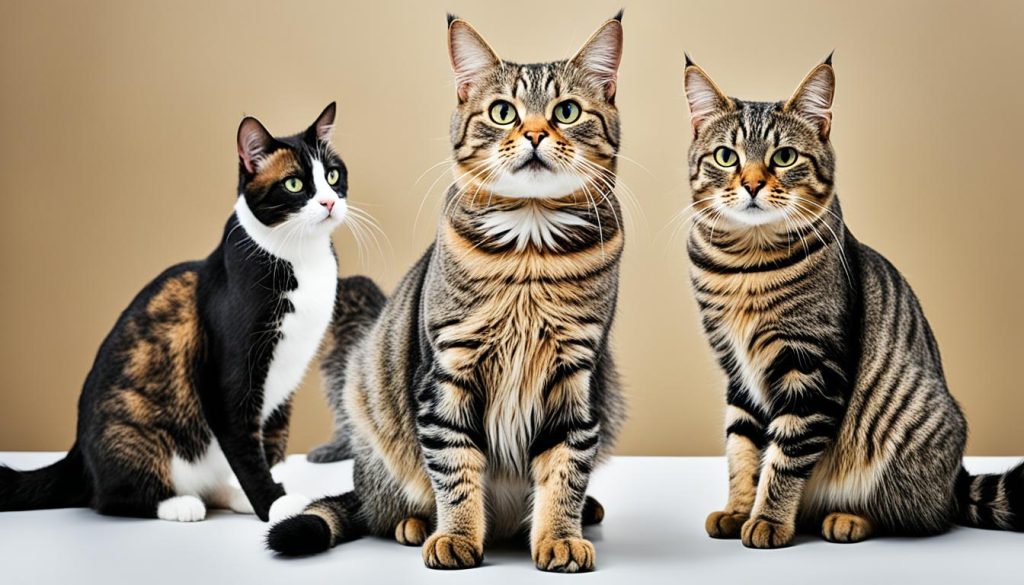
Understanding cat tail positions can help you interpret your cat’s emotions and needs more accurately. It is important to note that tail positions can vary between individual cats and should be considered alongside other body language cues to form a complete understanding of your cat’s communication.
Deciphering Cat Tail Positions
Below is a table illustrating common cat tail positions and their corresponding interpretations:
| Position | Meaning |
|---|---|
| Straight upright | Confidence, friendliness |
| Curved like a question mark | Curiosity, interest |
| Held close to the ground | Fear, anxiety |
| Fluffed up | Aggression, defensiveness |
| Wrapped around another cat or human | Affection, trust |
Assessing Your Cat’s Mood: Upright Tail Communication
When it comes to cat body language, the position of the tail can provide valuable insights into your feline friend’s mood and intentions. The posture of a cat’s tail can send subtle messages about their emotional state, and one such position is the straight, upright tail.
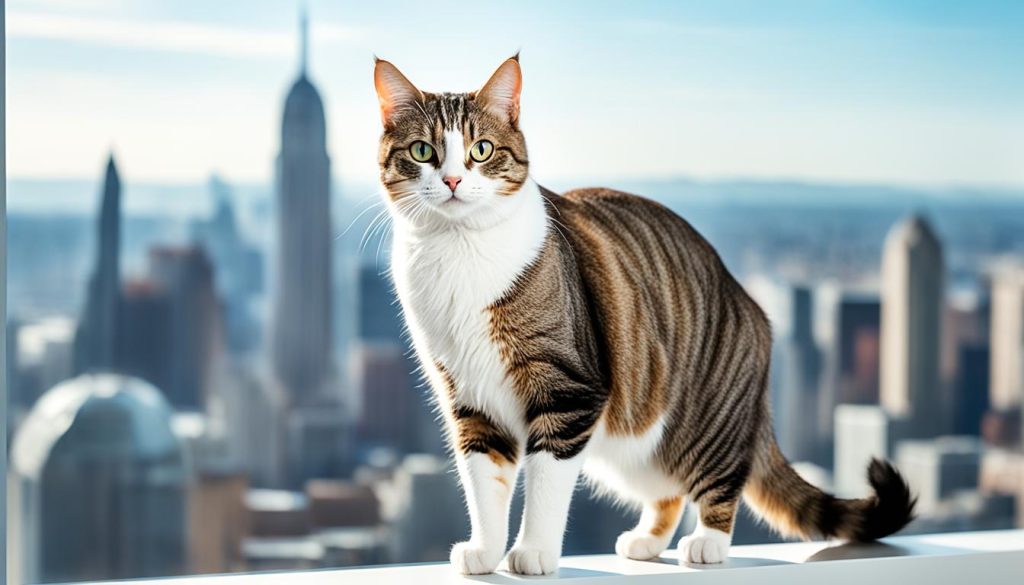
The straight tail signifies a positive mood and a willingness to interact. When a cat holds its tail up high and straight, it conveys confidence, comfort, and a friendly approach. This tail position indicates that your cat is open to engagement and is feeling at ease in their environment.
To fully understand your cat’s mood when their tail is upright, it’s important to consider other accompanying body language cues. A relaxed body posture, soft eyes, and upright ears may further confirm their positive disposition. By observing these additional signals, you can gain a more comprehensive understanding of your cat’s emotional state and tailor your responses accordingly.
Responding appropriately to a cat’s upright tail is crucial for fostering a positive relationship. When your cat extends their tail upward, it’s an invitation for interaction and companionship. You can reciprocate the friendly gesture by offering gentle petting, playing with toys, or engaging them in interactive activities they enjoy. This positive reinforcement strengthens the bond between you and your cat, demonstrating your understanding and respect for their communication cues.
| Indications of a Straight Tail in Felines | Responses to a Cat’s Upright Tail |
|---|---|
| The tail is held straight up and extended from the body. | Gently approach your cat and initiate interactive play or petting. |
| The tail remains rigid and motionless. | Use a soothing tone of voice to communicate positive reassurance. |
| The entire body appears relaxed and at ease. | Offer treats or engage your cat in their favorite activities. |
Interpreting the Curiosity in the Question Mark Tail
A cat’s tail forming a question mark shape indicates curiosity and interest. The curved tail tip signifies a desire to explore or investigate something. Understanding this tail position can help you engage in enriching activities with your cat and satisfy their curious nature. Discover how to interpret the question mark tail and encourage your cat’s curiosity.
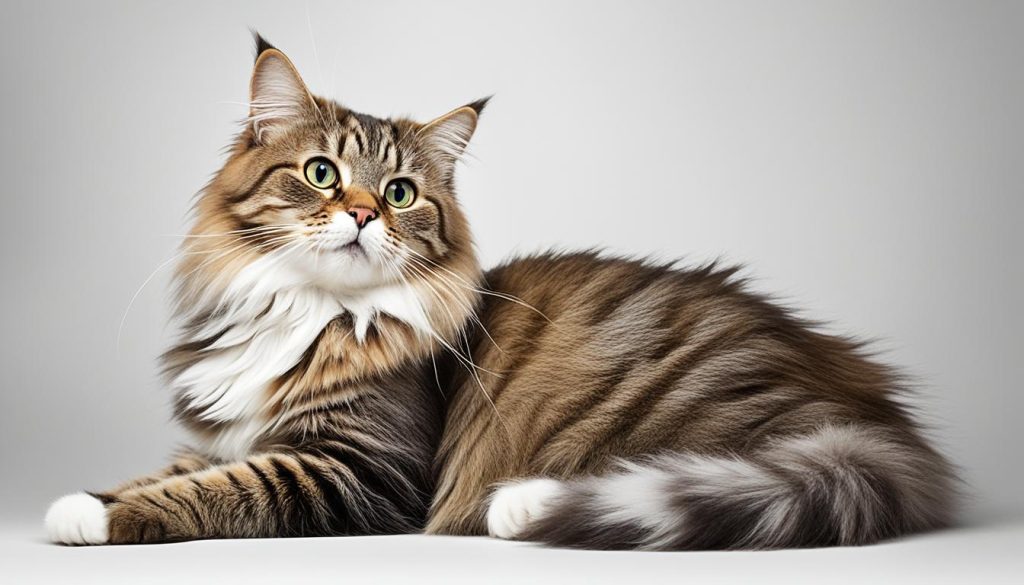
When a cat’s tail takes on the shape of a question mark, it’s a clear indicator of their curious nature. This tail gesture is often accompanied by an alert posture, with their ears forward and eyes focused on a particular object or situation. Your cat’s curiosity may be piqued by a new toy, an unfamiliar smell, or a sudden movement in their environment.
Interpreting the question mark tail can help you understand your cat’s interests and provide them with enriching experiences. When you notice this tail position, consider offering interactive toys or engaging in play sessions that stimulate their curiosity. This can include puzzle toys, treat-dispensing toys, or even playtime with a feather wand.
Encouraging your cat’s curiosity through tail interpretation not only enhances their mental stimulation but also strengthens the bond between you and your feline friend. By actively engaging with their inquisitive nature, you create opportunities for exploration and discovery, promoting a happy and contented cat.
| Cat Tail Gestures | Meaning |
|---|---|
| Question Mark Tail | Suggests curiosity and interest. |
| Curved Tail Tip | Signals a desire to explore or investigate. |
| Alert Posture | Accompanies the question mark tail, showcasing focus and attentiveness. |
Deducing Fear from a Tail Held Close to the Ground
When a cat holds its tail close to the ground or tucks it between its legs, it’s a clear indication of fear or anxiety. Cats have a distinct body language that includes tail signals to communicate their emotions and needs. The positioning of a cat’s tail plays a crucial role in expressing their state of mind.
When a cat feels threatened or scared, they instinctively lower their tail to make themselves appear smaller and less threatening. This defensive behavior is their way of trying to protect themselves from potential harm. By holding their tail close to the ground or tucking it between their legs, cats are signaling their fear to others.
Recognizing this fear signal is essential for cat owners to create a safe and calm environment for their feline companions. When a cat displays this kind of tail position, it’s important to approach them gently and avoid any sudden movements or loud noises. Providing a quiet and secure space for the cat to retreat to can help alleviate their anxiety.
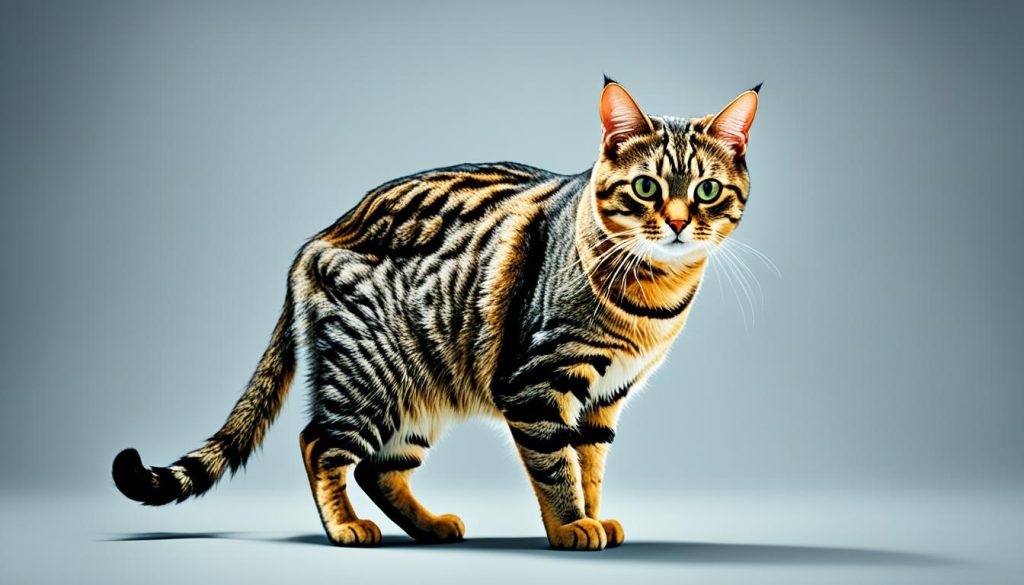
The Defensive Posture: Understanding Fluffed-Up Tails
When cats feel threatened or intimidated, they adopt a defensive posture known as a fluffed-up tail. This tail position is characterized by the tail becoming puffed and expanded, making the cat appear larger and more imposing to potential threats. Understanding the meaning behind a fluffed-up tail and knowing how to respond appropriately is crucial for ensuring your cat feels safe and protected.
Identifying Threat-Related Tail Puffing
Fluffing up their tails is a natural instinct for cats when they perceive danger or feel the need to defend themselves. The sudden expansion of their tail is an obvious visual cue that something is unsettling them. Pay attention to other accompanying body language cues, such as arched back, hissing, or flattened ears, to confirm that the tail puffing is indeed threat-related. Context is key in understanding whether the situation genuinely warrants a defensive response.
How to React to Your Cat’s Fluffed Tail
When encountering a cat with a fluffed-up tail, it’s essential to remain calm and avoid making sudden movements or loud noises. Aggressive or confrontational behavior towards the cat can escalate the situation further. Instead, create a quiet and safe environment for your cat by removing any potential stressors or threats. If the cause of their distress is another animal or an unfamiliar human, try to separate them and provide your cat with a secure and comfortable space. Give your cat time and space to calm down and regain their confidence.
| Signs of a Fluffed-Up Tail | Meaning |
|---|---|
| Tail becomes puffed and expanded | Defensive and threatened |
| Accompanied by arched back, hissing, or flattened ears | Heightened defensive response |
| No visible signs of relaxation or comfort | Continued state of alertness and tension |
What Do Cats Use Their Tails For
Cats are known for their remarkably expressive tails, but their functions go beyond communication. Understanding the purpose and versatility of a cat’s tail helps us appreciate this unique appendage. Let’s explore the multiple functions of cat tails and gain a deeper understanding of these fascinating creatures.
One of the primary functions of a cat’s tail is to aid in balance and agility. The tail acts as a counterbalance, allowing cats to make sharp turns, leap, and land gracefully. Whether scaling trees or navigating narrow spaces, the tail plays a crucial role in maintaining their stability and precision. Additionally, cat tails serve as essential tools for communication. When a cat feels threatened or fearful, it may puff up its tail to appear larger and more intimidating to potential threats. Conversely, a relaxed and friendly cat may hold its tail high and upright, indicating a positive mood and openness to interaction.
Furthermore, a cat’s tail helps to convey emotions. By observing the position and movements of their tails, we can gain valuable insights into a cat’s state of mind. Tails held close to the ground or wrapped tightly around the body may indicate fear or discomfort, while a gently swaying tail often signals relaxation and contentment. Cat tails also play a significant role in hunting techniques. They provide cats with enhanced coordination in chasing prey, enabling them to make quick turns and changes in direction. When stalking or hunting, a cat’s tail serves as a vital component of their predatory strategy.
Wrapped Tail Woes: Signs of Discomfort and Illness
When a cat wraps its tail tightly around its body, it can indicate cat tail discomfort, signs of illness in cat tails, or an underlying health issue. This behavior should raise concerns as it suggests that something may be amiss with your cat’s well-being. Recognizing the signs of a wrapped tail is crucial in ensuring prompt medical attention and early detection of potential health problems.
Wrapped tail meaning can vary depending on the context, but it often indicates discomfort or pain. Cats may wrap their tails around their bodies to protect the affected area or to alleviate the discomfort. It’s important to closely observe your cat’s behavior and look for any additional signs of illness or discomfort.
If you notice your cat’s tail consistently wrapped tightly around their body or if they exhibit other abnormal behaviors such as decreased appetite, lethargy, or unusual grooming habits, it’s essential to consult with a veterinarian. These can be indications of cat tail discomfort, signs of illness in cat tails, or underlying health issues that require professional care.
A veterinarian will perform a thorough examination to determine the cause of your cat’s wrapped tail and develop a treatment plan accordingly. Early intervention can prevent the progression of potential health problems and improve your cat’s overall well-being. Remember, paying attention to your cat’s tail language and promptly addressing any signs of discomfort or illness can make a significant difference in their quality of life.
Why Do Cats Wag Their Tails?
Cats have a unique way of expressing their emotions through tail wagging. Each movement of their tails carries a distinct meaning that reflects their current emotional state and serves as a method of communication with their surroundings. By understanding the connection between emotion and motion in their tail wagging behavior, we can gain deeper insights into cat behavior and enhance our ability to interpret their feelings.
Cat tail wagging is a fascinating form of cat body language that can convey a range of emotions. From excitement to fear, contentment to annoyance, cats use their tails as an expressive tool to communicate their innermost sentiments. A wagging tail can be a powerful indicator of their current emotional state, providing valuable clues for cat owners to decipher and respond to their needs.
It’s important to note that tail wagging in cats is not the same as in dogs. While a dog’s wagging tail is commonly associated with happiness and friendliness, the meaning of tail wagging in cats is more nuanced and context-dependent. For cats, tail wagging can indicate a variety of emotions beyond just joy.
To better understand the emotions behind cat tail movements, it is essential to pay attention to the accompanying body language cues. The position of their ears, the dilation of their pupils, and the overall posture of their body can offer valuable insights into the cat’s emotional state. By observing these cues in conjunction with tail wagging, we can develop a more comprehensive understanding of our feline friends’ feelings.
Exploring the connection between cat tail wagging and emotions can significantly enhance our ability to interpret and respond to our cats’ needs. By recognizing the subtle nuances of their tail movements, we can foster a deeper bond with our feline companions and create a harmonious environment that caters to their emotional well-being.
When Do Cats Wag Their Tails
Cat tail wagging is a common behavior that can convey various messages about a cat’s emotional state and intentions. Understanding when and why cats wag their tails can provide valuable insights into their overall behavior and well-being. The wagging of a cat’s tail can be triggered by a range of factors and situations. Some common triggers include:
- When a cat is excited or anticipating something, they may wag their tail in a rapid, back-and-forth motion.
- If a cat becomes agitated or annoyed, their tail may twitch or lash from side to side.
- Cats may wag their tails as a sign of frustration when they are unable to access something they desire.
- A cat may wag their tail slowly or in a stiff manner as a warning sign to communicate their discomfort or displeasure.
Other Ways Cats Communicate With Their Tails
While tail wagging is a prominent form of communication for cats, they also use their tails in various other ways to convey messages and establish non-verbal communication.
- The position of a cat’s tail can signal their overall mood and intentions. For example, a high, upright tail often indicates confidence and a friendly approach, while a tail held close to the body can indicate fear or submission.
- When a cat’s tail puffs up, it signifies a defensive posture adopted when they feel threatened or intimidated.
- Cats may wrap their tails around other cats or humans as a sign of affection, trust, and social bonding.
By exploring these different tail movements and their meanings, you can gain a deeper understanding of your cat’s non-verbal cues and strengthen your bond with them.
Why Cats Wrap Their Tails Around You and Their Feline Friends
Cats have a unique way of expressing their affection, comfort, and social bonds by wrapping their tails around you or other cats. This behavior serves multiple purposes and plays a crucial role in feline social dynamics.
When a cat wraps its tail around you, it is a sign of trust and friendship. It establishes a sense of security and intimacy between you and your feline companion. This tail wrapping behavior reflects their contentment and affection towards you, strengthening your bond and creating a deeper connection.
Similarly, when cats wrap their tails around each other, it is a way of fostering social bonds within the feline community. It helps establish a hierarchy, promotes camaraderie, and enhances social cohesion among cats. Through tail wrapping, cats communicate their acceptance, support, and willingness to engage in friendly interactions.
Understanding the reasons behind tail wrapping allows us to gain insights into cat behavior and the intricate dynamics of social bonding in cats. It is a testament to the depth of their emotions and their innate need for connection and companionship. By reciprocating this gesture and responding positively to their tail wrapping, you can further strengthen the bond between you and your cat. Engaging in gentle caresses, providing comfortable resting spaces, and spending quality time together are ways to nurture the deep friendship established through tail wrapping.
FAQs on why do cats wag their tails
What does it mean when a cat keeps wagging its tail?
When a cat keeps wagging its tail, it can indicate irritation, annoyance, or anger. This behavior serves as a warning that something is bothering the cat and that it may escalate if not addressed.
Do cats wag their tails when happy?
No, cats usually don’t wag their tails when they are happy. Tail wagging is more commonly associated with negative emotions such as annoyance, irritation, or anger.
Why do cats wiggle their tails while lying down?
Cats may wiggle their tails while lying down as a form of relaxation or contentment. It can also be a way for them to release excess energy or express happiness.
What do a cat’s tail movements mean?
A cat’s tail movements can have various meanings. Different positions and movements indicate different emotions and intentions. Understanding these movements helps interpret a cat’s behavior and needs.


